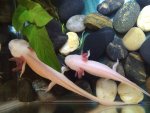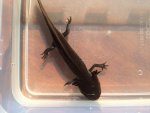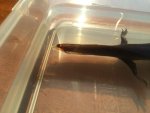Nanner
New member
- Joined
- Dec 21, 2015
- Messages
- 7
- Reaction score
- 0
- Points
- 0
- Location
- Terre Haute, Indiana
- Country
- United States
- Display Name
- Hannah
Hello fellow axolotl keepers.
I brought home my first axie tonight--one that I've had my eyes on for a while at a local aquatics store--and I went in a little half-cocked because I've been watching the little guy slowly waste away in his environment there. He stopped eating, is clearly emaciated, and his gills are disheveled. I don't have a picture right now simply because I don't want to disturb him. He is resting now his brand new ten gallon here at home. He has live plants, very little circulation, fine sand substrate, and a nice natural cave to hide in.
The temperature of the tank is currently 68 degrees, so it's a little higher than I want it but I will adjust that soon. I want to try to feed him some bloodworms tomorrow evening. The environment he had before was cluttered, unfiltered, full of minnows, and he had an inconsistent feeding schedule. We assume he was just rotting in ammonia. They say he was completely fine up until a few weeks ago.
I'm not sure if it's just me being hopeful, but he seems a little perkier in this new tank. I added a teaspoon of aquarium salt to encourage the function of his gills--I was too afraid to put more in even though he has ten gallons--and the water has been cycling for about a week. It's not perfect, but it's a heck of a lot better than he had, and I made sure to treat it for chlorine and bad gunk.
I have done mountains of research already, but I have no actual experience with axolotls, so I don't want to mess up. Is there anything that I can do that would definitely help him?
Thank you!
- Hannah
I brought home my first axie tonight--one that I've had my eyes on for a while at a local aquatics store--and I went in a little half-cocked because I've been watching the little guy slowly waste away in his environment there. He stopped eating, is clearly emaciated, and his gills are disheveled. I don't have a picture right now simply because I don't want to disturb him. He is resting now his brand new ten gallon here at home. He has live plants, very little circulation, fine sand substrate, and a nice natural cave to hide in.
The temperature of the tank is currently 68 degrees, so it's a little higher than I want it but I will adjust that soon. I want to try to feed him some bloodworms tomorrow evening. The environment he had before was cluttered, unfiltered, full of minnows, and he had an inconsistent feeding schedule. We assume he was just rotting in ammonia. They say he was completely fine up until a few weeks ago.
I'm not sure if it's just me being hopeful, but he seems a little perkier in this new tank. I added a teaspoon of aquarium salt to encourage the function of his gills--I was too afraid to put more in even though he has ten gallons--and the water has been cycling for about a week. It's not perfect, but it's a heck of a lot better than he had, and I made sure to treat it for chlorine and bad gunk.
I have done mountains of research already, but I have no actual experience with axolotls, so I don't want to mess up. Is there anything that I can do that would definitely help him?
Thank you!
- Hannah







